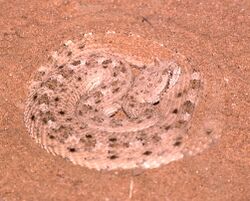Biology:Crotalus cerastes cercobombus
| Crotalus cerastes cercobombus | |
|---|---|

| |
| Scientific classification | |
| Domain: | Eukaryota |
| Kingdom: | Animalia |
| Phylum: | Chordata |
| Class: | Reptilia |
| Order: | Squamata |
| Suborder: | Serpentes |
| Family: | Viperidae |
| Genus: | Crotalus |
| Species: | |
| Subspecies: | C. c. cercobombus
|
| Trinomial name | |
| Crotalus cerastes cercobombus Savage & Cliff, 1953
| |
| Synonyms | |
| |
Crotalus cerastes cercobombus, commonly known as the Sonoran Desert sidewinder[2] or Sonoran sidewinder,[3] is a pitviper subspecies[4] found in the eastern part of the Sonoran Desert in the southwestern United States and northwestern Mexico. Like all pitvipers, it is venomous. The subspecific epithet means buzzertail.[3]
Description
This form has the following distinguishing characteristics: the proximal rattle-matrix lobe is black in adult specimens, the ventral scales number 132–144/138–148 in males/females, the subcaudals number 18-24/14-19 in males/females, and there are usually less than 21 rows of midbody dorsal scales.[5]
Geographic range
Found in the United States from Yuma, Maricopa, Pima and Pinal counties in Arizona, southward into Sonora, Mexico.[3] The type locality given is "near Gila Bend, Maricopa County, Arizona" (United States).[1]
Campbell and Lamar (2004) describe its range as the desert regions of south-central Arizona and parts of western Sonora, exclusive of the panhandle region in the west, but including Tiburon Island in the Gulf of California.[5]
Taxonomy
This subspecies was established by J.M. Savage and F.S. Cliff, based on information that had previously been published by Stanford, Klauber and Hensley. They described their new form, C. c. cercobombus, as occupying the eastern half of the range for C. c. laterorepens as defined by Klauber.[3]
References
- ↑ 1.0 1.1 McDiarmid RW, Campbell JA, Touré T. 1999. Snake Species of the World: A Taxonomic and Geographic Reference, vol. 1. Herpetologists' League. 511 pp. ISBN:1-893777-00-6 (series). ISBN:1-893777-01-4 (volume).
- ↑ Klauber LM. 1997. Rattlesnakes: Their Habitats, Life Histories, and Influence on Mankind. Second Edition. First published in 1956, 1972. University of California Press, Berkeley. ISBN:0-520-21056-5.
- ↑ 3.0 3.1 3.2 3.3 Wright AH, Wright AA. 1957. Handbook of Snakes. Comstock Publishing Associates. (7th printing, 1985). 1105 pp. ISBN:0-8014-0463-0.
- ↑ "Crotalus cerastes cercobombus". Integrated Taxonomic Information System. https://www.itis.gov/servlet/SingleRpt/SingleRpt?search_topic=TSN&search_value=209518. Retrieved 1 August 2007.
- ↑ 5.0 5.1 Campbell JA, Lamar WW. 2004. The Venomous Reptiles of the Western Hemisphere. Comstock Publishing Associates, Ithaca and London. 870 pp. 1500 plates. ISBN:0-8014-4141-2.
External links
- Crotalus cerastes at the Reptarium.cz Reptile Database. Accessed 3 August 2007.
Wikidata ☰ Q3698708 entry
 |

